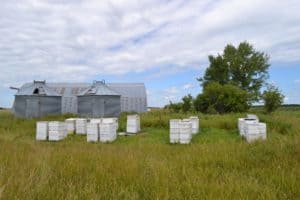Naming yards isn’t complicated but it’s an important aspect of managing a large commercial operation in order to facilitate communication between staff. Many states require apiary sites to be registered which requires filing paperwork that names the yard in addition to providing some basic information about location (latitude, longitude or nearest intersection), property ownership, and contact details. More importantly having yard names that are known to all of the staff in an operation allows management schedules and work plans to be made so crews can accomplish assigned tasks in appropriate places.

Selecting names is seemingly simple, the most common method is naming yards based on the Surname of the landowner e.g. Smith’s. On larger properties with multiple yards a simple modification like Smith’s 1, 2 & 3 or Smith’s East and West is an easy method of distinction. This can be adequate for some operations, but larger outfits may maintain several hundred apiaries and remembering hundreds of specific names when there is often minimal contact between landowner and beekeeping staff can be difficult. Yard names with descriptive locations or intersections e.g. 120th + County Line Rd are much more intuitive to learn. Using physical descriptors or landmarks is a great way to help crews learn locations. A yard name like Gravel Pit or Grain Bins that connects a visual cue to a site can be easier to remember than a landowners’ surname. Sometimes it’s most memorable to connect a memorable event to a yard. A site named ‘Dead body yard’ or ‘Burning couch’ isn’t likely to be forgotten. We have come across some very humorous and highly descriptive yard names and some that we cannot share on this blog. All are memorable.

It can be worthwhile to carry a yard list in each vehicle that shows contact information for land owners and notes like gate codes. A binder of maps with yard locations in vehicles can also be helpful in helping new employees with navigation. Some operations maintain a digital map of yards using drop pins which can be useful but may be inaccessible when needed in areas with poor data service. Since most yards are behind a locked gate or fence, having access or notes on how to enter the gate is the difference between inspecting in a timely fashion or waiting for someone to arrive to let you in. Some operations utilize sophisticated record keeping programs but something as simple as maintaining a yard list at the shop that records completion of a particular management objective (honey pull, treat, feed, etc.) through each yard can also be beneficial to keep all staff aware of overall progress. A overall map of locations kept on a wall in the shop can be useful for tracking hive management objectives and evening remembering which yards are currently populated (full, partial, empty). You wouldn’t think a load of bees would get ‘lost’ but it happens when multiple crews are moving thousands of hives in and out of pollination sets and there isn’t adequate communication and record keeping about who put what where.